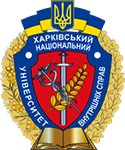Peculiarities of the classification of raw-smoked sausages during forensic commodity examination
Abstract
The main identification tasks of commodity examination of raw-smoked sausages are establishing their authenticity, determining compliance with safety and quality standards. To achieve these tasks, forensic experts conduct a number of studies and determinations, which include determining the composition of the product, determining the composition, quality and quantity of components, determining compliance with quality standards, as well as determining the content of atypical impurities and impurities. Carrying out these identification tasks, the examination allows to ensure the quality and safety of the product and forms the protection of consumer rights. Defects in raw-smoked sausages can occur for a variety of reasons and are usually the result of deficiencies in production, storage, or transportation.
The scientific article outlines the methodological features of conducting a forensic commodity examination of raw-smoked sausages, analyzes the theoretical and practical problems of the commodity research of raw-smoked sausages, defines the commodity aspects of raw-smoked sausages and their defects, systematizes information data on the algorithm for conducting a forensic commodity examination of raw-smoked sausages in order to check for the presence of characteristic defects. The stages of conducting a forensic commodity examination of raw smoked sausages are listed. Recommendations for quality assessment of raw-smoked sausages for expert organizations and consumers are offered. Prospective instrumental methods of examination of raw smoked sausages are defined, in particular spectral analysis, chromatographic methods, mass spectrometry, microscopy, thermal analysis; the main microbiological procedures that can be used during the examination of raw-smoked sausages are described; characteristic defects of raw-smoked sausages are summarized, including those that indicate its low quality or may be a sign of spoilage; describes the general sequence of actions that occur during the examination of this product.
Downloads
References
Kernasiuk, Yu. (2018, August 10). Meat market: main trends. Agribusiness Today. https://agro-business.com.ua/agro/ekonomichnyi-hektar/item/11153-rynok-miasa-osnovni-trendy.html.
Peshuk, L. V., & Klymenko, A. V. (2011). Composition for making raw smoked sausages for gourmets (Patent of Ukraine 69013, MPK A23L 1/315, A23L 1/317).
Bal-Prylypko, L. V. (2010). Technology of meat storage, preservation and processing. KVITs.
Klymenko, M. M., Vinnikova, L. H., Bereza, I. H. et al. (2006). Meat and meat products technology (M. M. Klymenko, Ed.). High Education.
Vinnikova, L. H. (2000). Theory and practice of meat processing. SMYL.
Incze, K. (1998, August 30 – September 4). Dry fermented sausages [Conference presentation abstract]. 44th International Congress of Meat Science and Technology “Meat Consumption and Culture”, Barcelona, Spain.
Peshuk, L., Ryabovol, M., & Klymenko, A. (2013). Development of smoked sausages of new generation. Ukrainian Food Journal, 2(2), 186–191.
Kyshenko, I. I., Topchii, O. A., Kryzhova, Yu. P., & Rybachuk, O. I. (2014). Starter crops for the production of smoked sausages. Food Science and Technology, 3(28), 23–27.
Tishkina, N. M., Lieshchova, M. O., & Іesina, E. V. (2018). Microstructural analysis of the quality of forcemeat in smoked sausages. Scientific Messenger of LNU of Veterinary Medicine and Biotechnologies. Series: Veterinary Sciences, 20(83), 268–273. https://doi.org/10.15421/nvlvet8353.
Lorenzo, J. M., Gómez, M., & Fonseca, S. (2014). Effect of commercial starter cultures on physicochemical characteristics, microbial counts and free fatty acid composition of dry-cured foal sausage. Food Control, 46, 382–388. https://doi.org/10.1016/j.foodcont.2014.05.025.
Kovbasenko, V. M. (2006). Veterinary and sanitary expertise with the basics of technology standardization of livestock products (Vol. II). INKOS.
Malyhina, V. D., Tytarenko, L. D., Porodina, L. V. et al. (2009). Basics of examination of food products. Kondor.
Syrokhman, I. V., & Lozova, T. M. (2009). Commodity science of meat and meat products. Center of Educational Literature.
Sachko, A. V., & Kobasa, I. M. (2017). Identifier for detection of falsification. Yuriy Fedkovych Chernivtsi National University.
Prytulska, N. V. (2005). Identification of Ancient Traditions: Theory and Practice. Kyiv National University of Trade and Economics.
Copyright (c) 2024 Ye. М. Sobakar, Ya. О. Kulyk

This work is licensed under a Creative Commons Attribution 4.0 International License.



